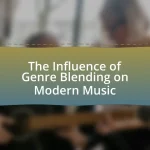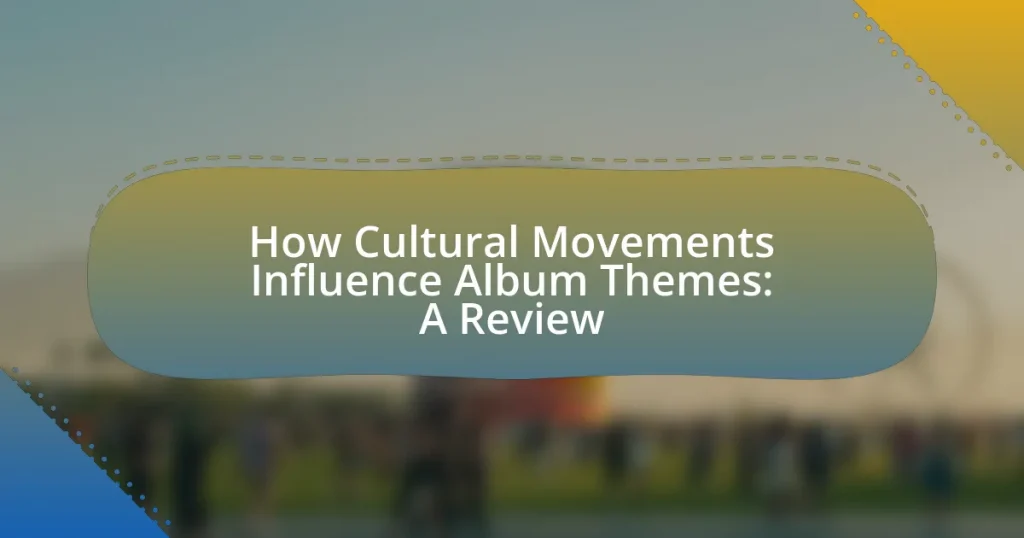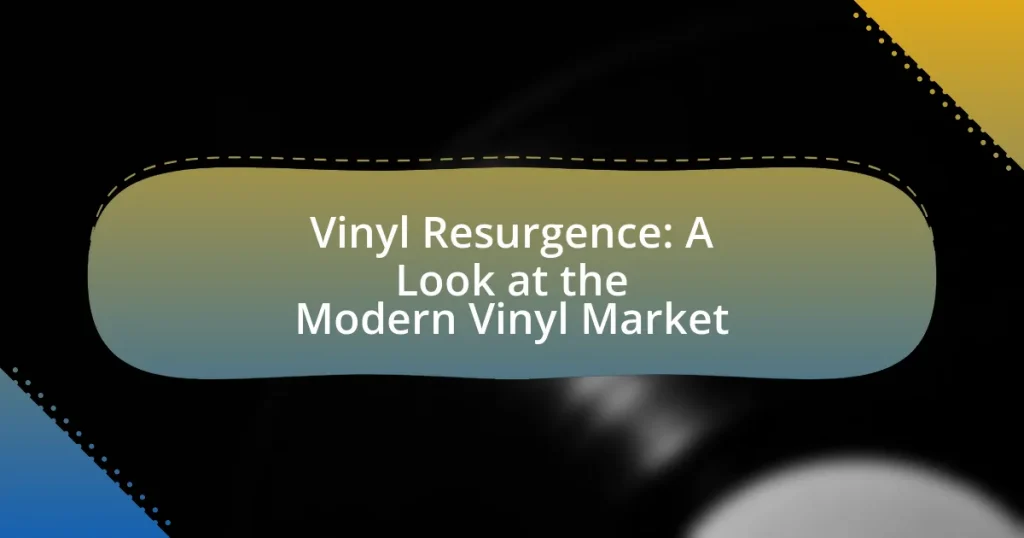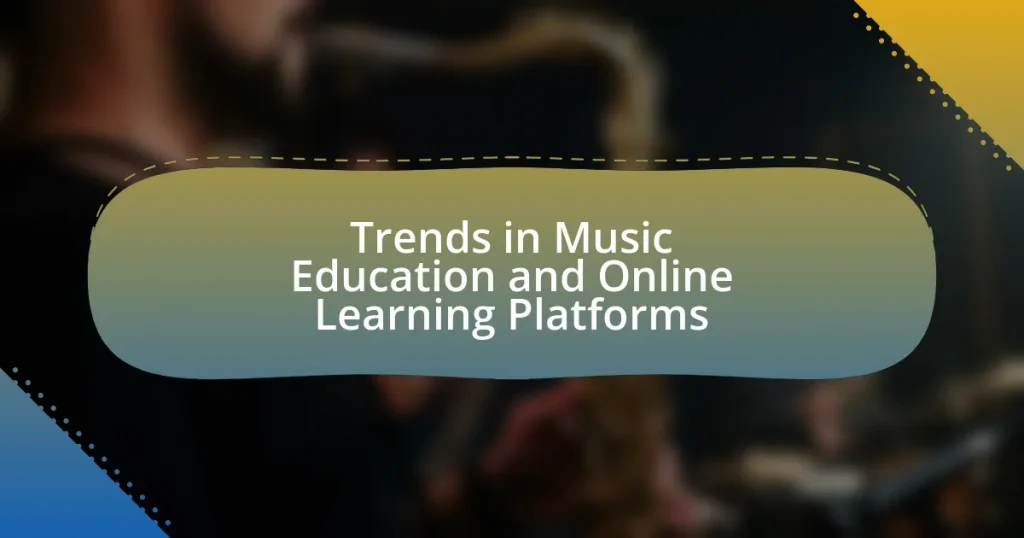The article examines how cultural movements shape album themes, highlighting the influence of significant historical events and social movements on musical expression. It discusses key cultural movements such as the Civil Rights Movement, Punk Rock, and the Counterculture Movement, illustrating how artists like Marvin Gaye and Bob Dylan responded to societal issues through their work. The article also explores the mechanisms through which cultural contexts inform album themes, the role of audience perceptions, and the impact of social media on music dissemination. Additionally, it provides notable examples of albums that reflect cultural movements and analyzes contemporary artists who continue this tradition in their music.
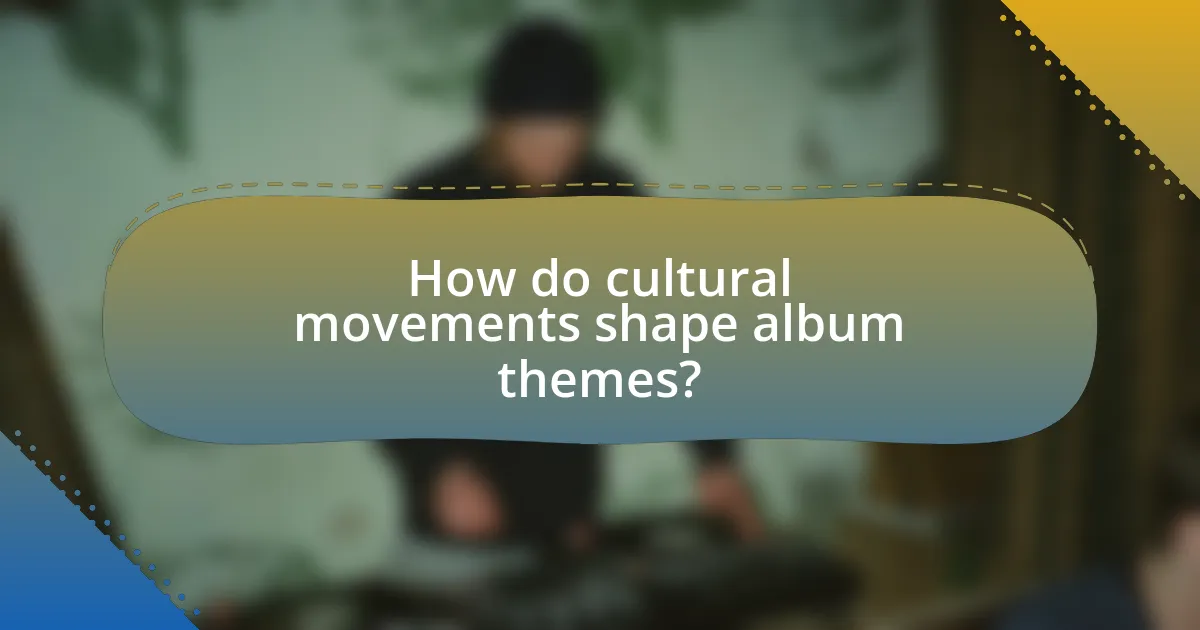
How do cultural movements shape album themes?
Cultural movements significantly shape album themes by influencing the artistic expression and lyrical content of musicians. For instance, the civil rights movement in the 1960s inspired numerous artists, leading to albums that addressed social justice, equality, and racial identity, such as Marvin Gaye’s “What’s Going On.” This album not only reflected the sentiments of the time but also became a cultural touchstone, illustrating how artists respond to and encapsulate the prevailing social issues. Additionally, the punk rock movement of the 1970s and 1980s produced albums that critiqued societal norms and political structures, as seen in The Clash’s “London Calling,” which addressed themes of rebellion and disillusionment. These examples demonstrate that cultural movements provide a framework for artists to explore and articulate the collective experiences and emotions of their communities, thereby shaping the thematic direction of their albums.
What are the key cultural movements that have influenced music?
Key cultural movements that have influenced music include the Renaissance, Romanticism, Jazz Age, Civil Rights Movement, and Punk Rock. The Renaissance, spanning the 14th to 17th centuries, emphasized humanism and led to the development of polyphony in music. Romanticism, in the 19th century, focused on emotional expression, influencing composers like Chopin and Wagner. The Jazz Age in the 1920s introduced improvisation and syncopation, shaping genres like jazz and blues. The Civil Rights Movement of the 1960s inspired protest songs that addressed social justice, with artists like Bob Dylan and Nina Simone at the forefront. Punk Rock emerged in the 1970s as a reaction against mainstream music, promoting DIY ethics and political messages, exemplified by bands like The Ramones and The Sex Pistols. Each of these movements significantly shaped musical styles, themes, and societal messages within their respective eras.
How did the counterculture movement impact album themes in the 1960s?
The counterculture movement significantly influenced album themes in the 1960s by promoting messages of social change, anti-establishment sentiments, and exploration of consciousness. Artists like Bob Dylan and The Beatles incorporated themes of peace, love, and rebellion against societal norms into their music, reflecting the values of the movement. For instance, Dylan’s “The Times They Are a-Changin'” became an anthem for change, while The Beatles’ “Sgt. Pepper’s Lonely Hearts Club Band” embraced psychedelic experiences and communal living, mirroring the counterculture’s ideals. This shift in thematic focus marked a departure from traditional music, aligning with the broader cultural upheaval of the era.
What role did the civil rights movement play in shaping musical narratives?
The civil rights movement significantly influenced musical narratives by providing a platform for artists to express social justice themes and advocate for equality. Musicians like Nina Simone and Sam Cooke used their songs to address racial discrimination and inspire activism, with tracks such as “Mississippi Goddam” and “A Change Is Gonna Come” becoming anthems of the movement. This integration of political messages into music not only reflected the struggles of African Americans but also galvanized public support for civil rights, demonstrating the power of music as a tool for social change.
Why is it important to analyze the relationship between culture and music?
Analyzing the relationship between culture and music is important because it reveals how societal values, beliefs, and experiences shape musical expression. Music often reflects cultural identity, serving as a medium for storytelling and communication that captures the essence of a community’s history and social dynamics. For instance, the civil rights movement in the United States produced powerful songs that articulated the struggles and aspirations of African Americans, such as “We Shall Overcome,” which became an anthem for change. This connection underscores the role of music as both a cultural artifact and a catalyst for social movements, highlighting its significance in understanding cultural evolution and influence.
How does understanding cultural context enhance the listening experience?
Understanding cultural context enhances the listening experience by providing deeper insights into the themes, emotions, and messages conveyed in music. When listeners are aware of the historical, social, and political backgrounds that shape a piece of music, they can interpret lyrics and sounds more meaningfully. For instance, an album released during a significant cultural movement, such as the Civil Rights Movement in the 1960s, often reflects the struggles and aspirations of that time, allowing listeners to connect more profoundly with the artist’s intent and the societal issues addressed. This connection is supported by research indicating that music is often a reflection of cultural narratives, which can evoke stronger emotional responses when listeners recognize and understand these narratives.
What insights can be gained from examining album themes through a cultural lens?
Examining album themes through a cultural lens reveals how societal values, historical events, and collective experiences shape musical narratives. For instance, albums released during significant cultural movements, such as the civil rights movement in the 1960s, often reflect themes of resistance and empowerment, as seen in works by artists like Nina Simone and Marvin Gaye. These thematic explorations provide insights into the emotional and social contexts of the time, illustrating how music serves as both a reflection and a catalyst for cultural change. Furthermore, analyzing the lyrics and artistic choices within these albums can uncover deeper meanings related to identity, race, and social justice, thereby enhancing our understanding of the interplay between culture and music.
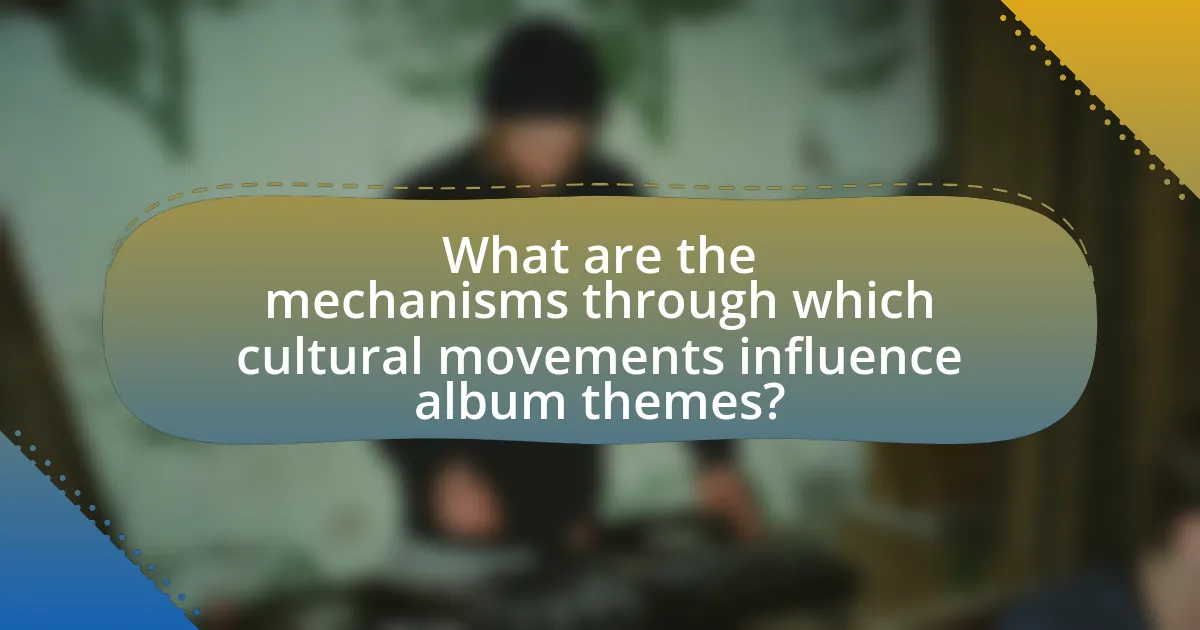
What are the mechanisms through which cultural movements influence album themes?
Cultural movements influence album themes through social context, artistic expression, and audience engagement. Social context shapes the themes by reflecting the prevailing issues, values, and sentiments of the time, such as the civil rights movement influencing music in the 1960s, where artists like Bob Dylan and Nina Simone addressed social justice. Artistic expression allows musicians to channel their experiences and perspectives shaped by cultural movements, as seen in punk rock’s emergence as a response to political disillusionment in the 1970s. Audience engagement further drives album themes, as artists often respond to the desires and expectations of their listeners, which can be informed by cultural trends, such as the rise of hip-hop reflecting urban experiences and struggles. These mechanisms collectively demonstrate how cultural movements serve as a catalyst for thematic development in music albums.
How do artists reflect societal changes in their music?
Artists reflect societal changes in their music by addressing contemporary issues, emotions, and cultural movements that resonate with their audience. For instance, during the civil rights movement, artists like Bob Dylan and Nina Simone created songs that highlighted social injustices and called for change, such as Dylan’s “The Times They Are a-Changin'” and Simone’s “Mississippi Goddam.” These works not only captured the sentiments of the time but also influenced public opinion and activism. Additionally, genres like punk and hip-hop emerged as responses to societal discontent, with artists using their platforms to critique political systems and advocate for marginalized communities. This direct engagement with societal issues demonstrates how music serves as both a reflection and a catalyst for change.
What techniques do musicians use to convey cultural messages in their albums?
Musicians use various techniques to convey cultural messages in their albums, including lyrical content, instrumentation, visual aesthetics, and collaboration with cultural figures. Lyrical content often reflects social issues, historical events, or cultural narratives, allowing artists to express their perspectives and connect with listeners on a deeper level. For example, Kendrick Lamar’s album “To Pimp a Butterfly” addresses systemic racism and personal identity, using storytelling to highlight cultural struggles. Instrumentation can also play a significant role; artists may incorporate traditional instruments or styles from their cultural backgrounds to create an authentic sound that resonates with their heritage. Visual aesthetics, such as album artwork and music videos, further enhance cultural messages by using symbols, colors, and imagery that represent specific cultural identities or movements. Collaborating with cultural figures or incorporating elements from various cultures can broaden the message and foster a sense of community. These techniques collectively enable musicians to articulate and share cultural messages effectively, making their work relevant to contemporary social dialogues.
How do collaborations with other artists enhance cultural themes in albums?
Collaborations with other artists enhance cultural themes in albums by integrating diverse perspectives and influences that reflect a broader cultural narrative. When artists from different backgrounds collaborate, they bring unique cultural elements, musical styles, and lyrical themes that can resonate with a wider audience. For instance, the collaboration between Shakira and Wyclef Jean on “Hips Don’t Lie” not only blended Latin and hip-hop influences but also highlighted cultural fusion, showcasing how music can transcend geographical boundaries. This blending of styles often leads to richer storytelling and a more profound exploration of cultural identity, as seen in projects like “Black Panther: The Album,” which features various artists contributing to a cohesive cultural theme that celebrates African heritage. Such collaborations can also spark conversations about cultural issues, making the music more relevant and impactful.
In what ways do audience perceptions shape album themes?
Audience perceptions shape album themes primarily through the feedback loop between artists and listeners, influencing the creative direction and thematic focus of the music. When audiences resonate with specific messages or emotions conveyed in an album, artists often adapt their future work to align with these perceptions, creating a dialogue that reflects cultural sentiments. For example, the rise of social media has enabled immediate audience reactions, allowing artists to gauge public sentiment and adjust their themes accordingly, as seen in the works of artists like Taylor Swift, who has shifted her lyrical focus based on fan interactions and societal trends. This dynamic interaction illustrates how audience perceptions not only inform but also actively shape the thematic landscape of music albums.
How does fan culture influence the direction of musical themes?
Fan culture significantly influences the direction of musical themes by shaping artists’ creative choices and the subjects they explore. For instance, when fans express strong preferences for specific themes, such as social justice or personal struggles, artists often respond by incorporating these elements into their music to maintain relevance and connection with their audience. A notable example is the rise of hip-hop artists addressing systemic racism and inequality, driven by fan activism and societal movements, which has led to critically acclaimed albums like Kendrick Lamar’s “To Pimp a Butterfly.” This demonstrates how fan culture not only reflects but also actively drives the thematic evolution in music, as artists align their work with the values and interests of their fanbase.
What role does social media play in the dissemination of cultural themes in music?
Social media serves as a crucial platform for the dissemination of cultural themes in music by enabling artists to share their work directly with audiences and fostering community engagement. This direct interaction allows for the rapid spread of cultural narratives, as platforms like Instagram, Twitter, and TikTok facilitate the sharing of music, videos, and discussions that highlight specific cultural themes. For instance, the viral success of songs like “Old Town Road” by Lil Nas X demonstrates how social media can amplify cultural conversations around genre blending and identity, leading to widespread recognition and influence. Additionally, research indicates that social media engagement can significantly impact music consumption patterns, with 54% of users discovering new music through social platforms, thereby reinforcing the role of social media in shaping cultural themes within the music industry.
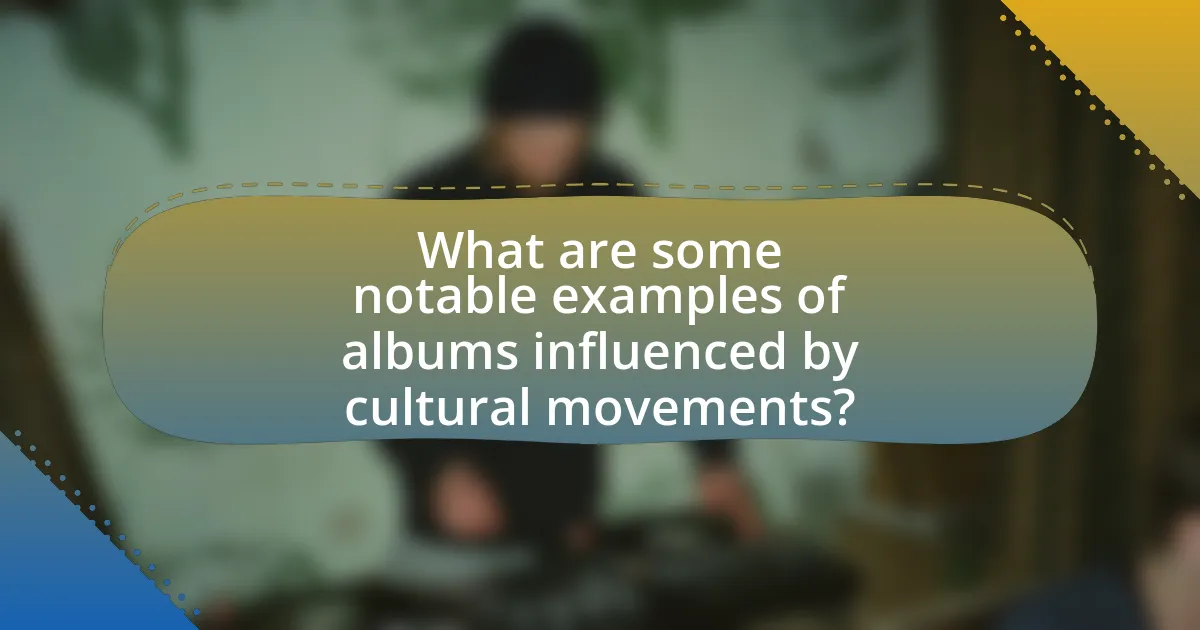
What are some notable examples of albums influenced by cultural movements?
Notable examples of albums influenced by cultural movements include “What’s Going On” by Marvin Gaye, which reflects the civil rights and anti-war movements of the 1960s and 1970s, addressing social issues such as poverty and environmental concerns. Another significant album is “The Miseducation of Lauryn Hill,” which draws from the Black feminist movement and explores themes of identity, love, and empowerment. Additionally, “London Calling” by The Clash is heavily influenced by the punk rock movement and addresses political and social unrest in the late 1970s. These albums not only showcase the artists’ responses to their cultural contexts but also serve as historical documents that capture the essence of the movements they represent.
Which albums are considered milestones in reflecting cultural movements?
Albums considered milestones in reflecting cultural movements include “Sgt. Pepper’s Lonely Hearts Club Band” by The Beatles, which encapsulated the counterculture of the 1960s and the psychedelic movement. Another significant album is “The Times They Are a-Changin'” by Bob Dylan, which became an anthem for the civil rights movement and anti-war protests in the 1960s. “What’s Going On” by Marvin Gaye is also pivotal, addressing social issues such as poverty and war during the Vietnam era. Additionally, “Nevermind” by Nirvana marked the rise of grunge and the disillusionment of Generation X in the early 1990s. Each of these albums not only reflects the cultural sentiments of their respective eras but also influenced societal perspectives and movements.
How did “What’s Going On” by Marvin Gaye address social issues of its time?
“What’s Going On” by Marvin Gaye addressed social issues of its time by highlighting themes of civil rights, environmental concerns, and the impact of war. The album emerged during the 1960s and early 1970s, a period marked by significant social upheaval, including the civil rights movement and protests against the Vietnam War. Gaye’s lyrics reflect the struggles of marginalized communities, emphasizing the need for love and understanding amidst societal turmoil. For instance, the song “Mercy Mercy Me (The Ecology)” directly addresses environmental degradation, while “Inner City Blues (Make Me Wanna Holler)” articulates the frustrations of urban poverty. These themes resonated with listeners, making the album a powerful commentary on the pressing social issues of its era.
What themes are explored in “The Miseducation of Lauryn Hill” related to feminism and identity?
“The Miseducation of Lauryn Hill” explores themes of feminism and identity through the lens of self-empowerment, motherhood, and the intersectionality of race and gender. Hill’s lyrics emphasize the importance of female autonomy and the complexities of womanhood, addressing societal expectations and personal struggles. For instance, the song “Doo Wop (That Thing)” critiques the pressures on women to conform to certain roles while advocating for self-respect and authenticity. Additionally, Hill’s reflections on her identity as a Black woman highlight the challenges faced within both feminist and racial contexts, illustrating how these identities shape her experiences and perspectives. This multifaceted approach underscores the album’s significance in discussions of feminism and identity within the cultural landscape of the late 1990s.
How do contemporary artists continue this tradition?
Contemporary artists continue the tradition of cultural movements influencing album themes by integrating current social issues, personal narratives, and diverse musical styles into their work. For instance, artists like Kendrick Lamar and Billie Eilish address themes of mental health, identity, and social justice, reflecting the ongoing dialogues within society. This approach not only honors the historical context of music as a form of expression but also adapts it to resonate with modern audiences, thereby maintaining the relevance of cultural movements in shaping artistic output.
What recent albums have drawn inspiration from current cultural movements?
Recent albums that have drawn inspiration from current cultural movements include “Renaissance” by Beyoncé, which reflects themes of empowerment and LGBTQ+ rights, and “Mr. Morale & The Big Steppers” by Kendrick Lamar, addressing mental health and social justice issues. These albums resonate with contemporary cultural dialogues, showcasing how artists engage with and respond to societal changes. For instance, “Renaissance” celebrates queer culture and self-acceptance, while Kendrick Lamar’s work highlights the struggles and complexities of identity in today’s society.
How do modern genres incorporate cultural themes in their lyrics and visuals?
Modern genres incorporate cultural themes in their lyrics and visuals by reflecting societal issues, traditions, and identities relevant to specific communities. For instance, hip-hop often addresses themes of racial inequality and social justice, as seen in tracks by artists like Kendrick Lamar, whose album “To Pimp a Butterfly” explores African American culture and systemic oppression. Similarly, reggaeton integrates Latin American cultural elements, using visuals and lyrics that celebrate heritage and address contemporary social issues, as exemplified by Bad Bunny’s work. These genres utilize storytelling and symbolism to resonate with audiences, making cultural themes a central aspect of their artistic expression.
What best practices can artists follow to effectively incorporate cultural themes into their albums?
Artists can effectively incorporate cultural themes into their albums by conducting thorough research on the cultural elements they wish to represent. This involves understanding the historical context, significance, and nuances of the culture, which can enhance authenticity. For instance, artists like Kendrick Lamar have successfully integrated cultural narratives by exploring themes of identity and social justice, reflecting the African American experience. Additionally, collaborating with cultural experts or community members can provide deeper insights and ensure respectful representation. This practice not only enriches the album’s content but also fosters a connection with the audience, as seen in the works of artists like Shakira, who incorporates Latin influences and themes into her music, resonating with diverse audiences.








